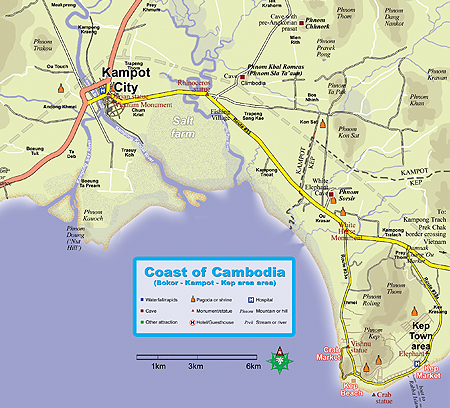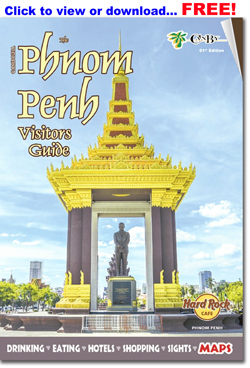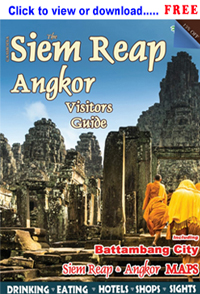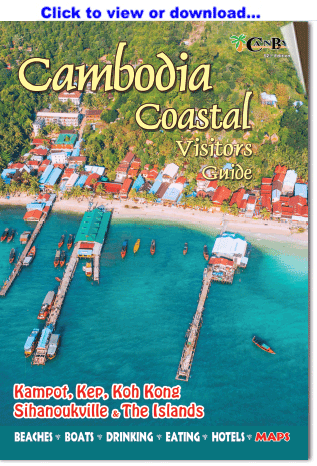|
Temples of the Angkor Archaeological Park and
Siem Reap
Province
The following temple ruins
are located in Siem Reap Province, most within the boundaries of the
Angkor Archaeological Park near
Siem Reap City. The temple sites with the
Angkor Archaeological Park represent the
ruins of the ancient Angkorian capital cities of the Khmer Empire
(9th-13th century AD) and include the
most famous Khmer temples including
Angkor Wat and
Bayon.
In the list below click on the temple name
for more information and photos. |
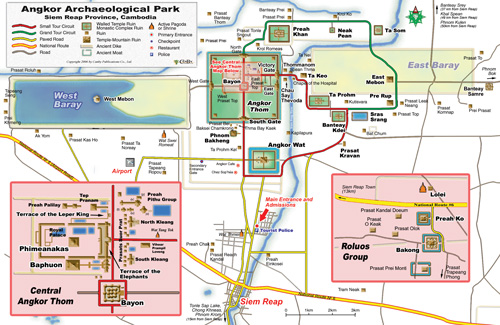 |
|
|
Temple
Ruin
CLICK temple name
for more information |
Location |
Date of Construction |
King/Patron |
Style |
|
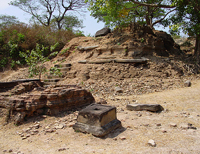 |
Ak Yum
Very early ruins. |
AAP - Near the West
Baray |
8th-11th century AD |
--- |
--- |
|
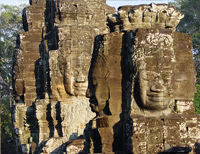 |
Angkor Thom
The walled city of Jayavarman VII. |
AAP |
12th-13th century AD |
Jayavarman VII |
Bayon |
|
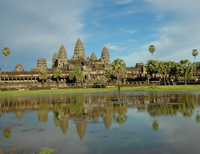 |
Angkor Wat
The centerpiece of Angkor. |
AAP - 6km north of
Siem Reap Town. |
Early-Mid 12th
century AD |
Suryavarman II |
Angkor Wat |
|
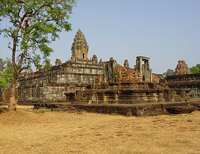 |
Bakong
Largest temple in the Roluos Group. |
AAP - Roluos Group |
Early 9th century AD |
Indravarman |
Preah Ko |
|
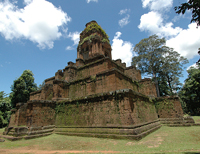 |
Baksei Chamkrong
Temple pyramid near the South Gate
of Angkor Thom. |
AAP/PC - Near the
South Gate of Angkor Thom |
Mid 10th century AD |
Harshavarman |
Bakheng |
|
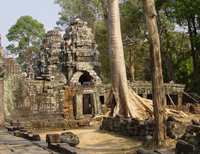 |
Banteay Kdei
Monastic-complex. |
AAP/GC |
Late 12th - Early
13th century AD |
Jayavarman VII |
Angkor Wat/ Bayon |
|
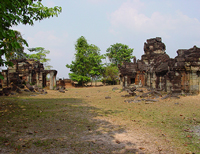 |
Banteay Prei
|
AAP/GC |
Late 12th - Early
13th century AD |
Jayavarman VII |
Bayon |
|
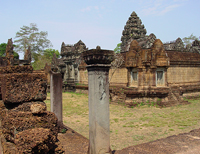 |
Banteay Samre
Distinctly Angkor Wat architectural style,
but a lot fewer tourists. |
AAP - 4km east of
East Mebon |
Mid 12th century AD |
Suryavarman II |
Angkor Wat |
|
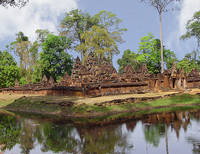 |
Banteay Srey
Citadel of Women. Some of the most
beautiful carvings at Angkor. |
37km north of Siem
Reap Town |
Late 10th century AD |
Rajendravarman |
Banteay Srey |
|
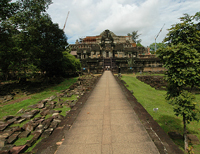 |
Baphuon
Newly restored and reopened. Look
for the reclining Buddha on the west side. |
AAP/PC - Central
Angkor Thom |
Mid 11th century AD |
Udayadityavarman II |
Baphuon |
|
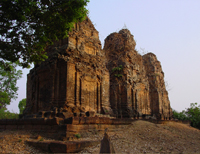 |
Bat Chum
Three well preserved prasats in a
quiet area. |
AAP/PC |
Mid 10th century AD |
Rajendravarman |
Pre Rup |
|
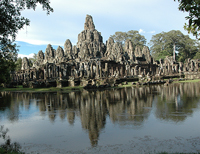 |
Bayon
The Temple of Faces at the center of
Angkor Thom. |
AAP/PC - Central
Angkor Thom |
Late 12th century AD |
Jayavarman VII |
Bayon |
|
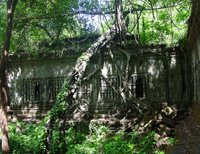 |
Beng Melea
Jungle temple. |
|
Early 11th century AD |
Suryavarman II |
Angkor Wat |
|
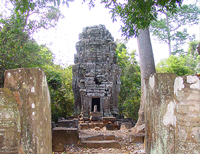 |
Chapel of the Hospital
One of more than 100 Angkorian
'hospitals.' |
AAP/PC |
Late 12th century AD |
Jayavarman VII |
Bayon |
|
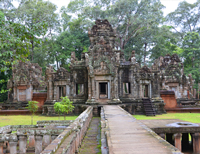 |
Chau Say Tevoda
Newly restored. |
AAP/PC |
Early 12th century AD |
Suryavarman II |
Angkor Wat |
|
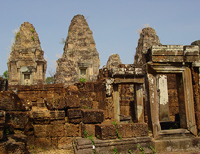 |
East Mebon
Temple mountain. |
AAP/GC |
Late 10th century AD |
Rajendravarman II |
Pre Rup |
|
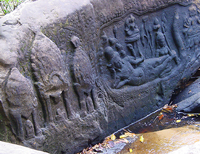 |
Kbal Spean
River carvings outside the park
area. |
49km north of Siem
Reap Town |
11th - 13th century
AD |
|
|
|
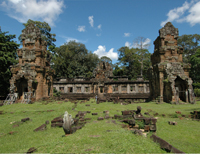 |
Kleangs (North and South)
'The Royal Storehouse'
|
AAP/PC - Central
Angkor Thom |
Late 10th - Early
11th century AD |
Jayavarman V |
Khleang |
|
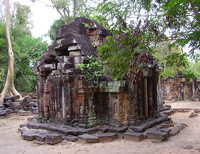 |
Krol Ko
Quiet area. |
AAP/GC |
Late 12th century AD |
Jayavarman VII |
Bayon |
|
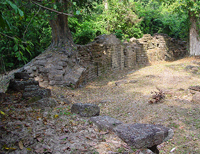 |
Krol Romeas
Little more than a wall. |
AAP/GC |
|
|
|
|
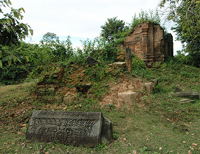 |
Kutisvara
Very early ruin. |
AAP/GC |
9th / 10th century AD |
Jayavarman II |
Preah Ko |
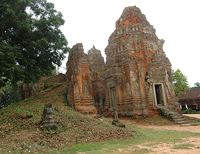 |
Lolei
Large brick prasats, good lintel
carvings and an active pagoda. |
AAP - Roluos Group |
Late 9th century AD |
Yasovarman I |
Pre Rup/Bakheng |
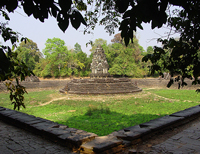 |
Neak Pean
Full of interesting details: the
different heads in each water inlet; the encoiled tails of the
serpent; the statue of Balaha, a replica of which adorns the
Siem Reap Airport. |
AAP/GC |
Late 12th century AD |
Jayavarman VII |
Bayon |
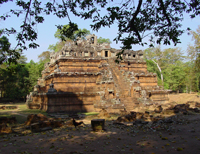 |
Phimeanakas
Scalable temple pyramid in central
Angkor Thom. |
AAP/PC - Central
Angkor Thom |
Late 10th - Early
11th century AD |
Jayavarman V |
Khleang |
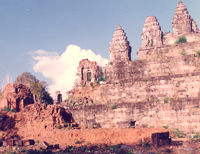 |
Phnom Bakheng
The traditional sunset hill, though
very over-touristed at sunset these days. |
AAP/PC - Near the
South Gate of Angkor Thom |
Late 9th - Early 10th century
AD |
Yasovarman I |
Bakheng |
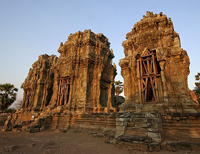 |
Phnom Krom
Hilltop prasats overlooking the
Tonle Sap. |
15km south of Siem
Reap Town, near the Chong Khneas Port |
Late 9th - Early 10th
century AD |
Yasovarman I |
Bakheng |
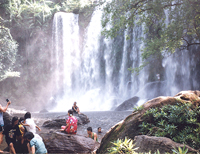 |
Phnom Kulen
Where Angkor began. |
50km north of Siem
Reap Town |
9th century AD |
Jayavarman II |
Kulen |
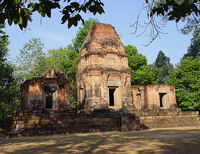 |
Prasat Bei
|
AAP/PC - Near the
South Gate of Angkor Thom |
10th century AD |
Yasovarman I |
Bakheng |
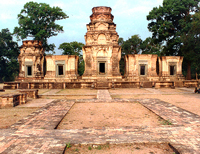 |
Prasat Kravan
Impressive interior bas-reliefs. . |
AAP/PC |
Early 10th century AD |
Harshavarman I |
Pre Rup |
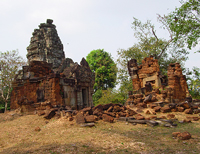 |
Prasat Prei
Quiet area. |
AAP/GC |
Late 12th - Early
13th century AD |
Jayavarman VII |
Bayon |
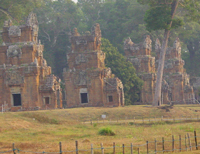 |
Prasat Suor Prat
A dozen towers facing Terrace of the
Elephants. |
AAP/PC - Central
Angkor Thom |
Early 13th? century
AD |
Indravarman II |
Post-Bayon |
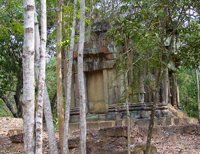 |
Prasat Top (East)
A.k.a: 'Monument 487,' 'Mangalartha,'
reputedly the last Bramanistic structure at Angkor built in the
Angkorian age. |
Angkor Thom |
Late 13th century AD |
Jayavarman VII |
Bayon |
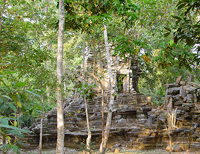 |
Prasat Top (West)
|
Angkor Thom |
9th-17th century AD |
|
Post-Bayon |
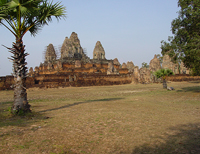 |
Pre Rup
Temple mountain. Good carvings. |
AAP/GC |
Late 10th century AD |
Rajendravarman II |
Pre Rup |
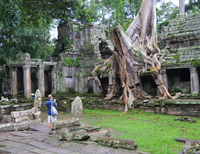 |
Preah Khan
Sprawling monastic-complex style
temple.
|
AAP/GC |
Late 12th century AD |
Jayavarman VII |
Bayon |
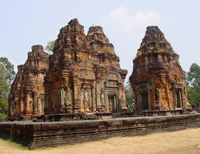 |
Preah Ko
Temple of 'the Sacred Cow' at
Roluos. |
AAP - Roluos Group |
Late 9th century AD |
Indravarman I |
Preah Ko |
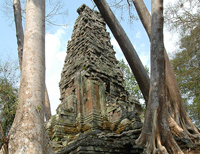 |
Preah Palilay
Tower on a mound. Good carvings on
the gopura. |
AAP/PC - Central
Angkor Thom |
Late 12th - Early
13th century AD |
Jayavarman VII |
Bayon |
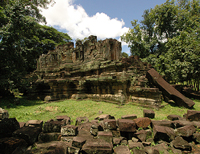 |
Preah Pithu Group
Pleasantly untourists group of Hindu
and Buddhist temple near Terrace of Elephants. |
AAP/PC - Central
Angkor Thom |
Early 12th century AD |
Suryavarman II |
|
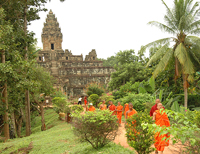 |
Roluos Group
The first Angkorian capital city -
Bakong, Preah Ko and Lolei. |
AAP - Roluos Group |
Late 9th century AD |
|
|
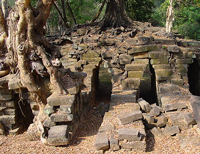 |
Spean Thma
Interesting to note how the river
has changed course over the centuries. |
AAP/PC |
|
|
|
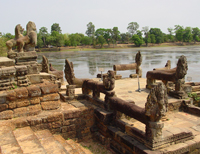 |
Srah Srang
Royal baray. Good alternative
sunrise/sunset location. |
AAP/PC |
Mid 10th and Late 12th
century AD |
Jayavarman VII |
Bayon |
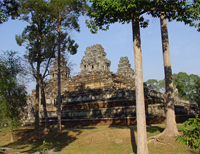 |
Ta Keo
Big and kind of plain. |
AAP/PC |
Late 10th - Early
11th century AD |
Jayavarman V |
Khleang |
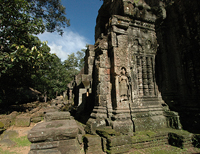 |
Ta Nei
Quiet location off the beaten path,
but within the Angkor Park |
AAP |
Mid 12th century AD |
Jayavarman VII |
Bayon |
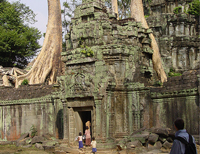 |
Ta Prohm
The jungle temple. Sprawling
monastic-complex, much of the original jungle overgrowth left in
place. Classic 'giant tree on temple' shots. |
AAP/PC |
Mid 12th - Early 13th
century AD |
Jayavarman VII |
Bayon |
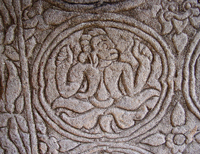 |
Ta Prohm Kel
Another of the small 'hospital'
prasats, similar to Chapel of the Hospital. |
AAP/PC - Opposite
Angkor Wat |
Late 12th century AD |
Jayavarman VII |
Bayon |
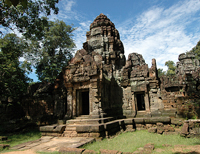 |
Ta Som
Fantastic little monastic-complex,
like a miniature Ta Prohm. Very photogenic our-face towers with
trees. |
AAP/GC |
Late 12th century AD
century AD |
Jayavarman VII |
Bayon |
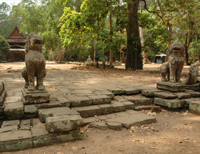 |
Tep Pranam
Also the site of an active pagoda. |
AAP/PC - Central
Angkor Thom |
9th century AD |
Jayavarman VII |
Bayon |
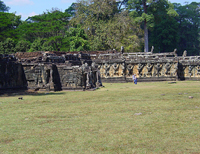 |
Terrace of the Elephants
Elephants and garudas, lots of them. |
AAP/PC - Central
Angkor Thom |
Late 12th century AD |
Jayavarman VII |
Bayon |
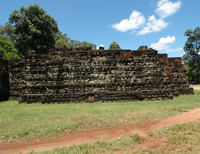 |
Terrace of the Leper King
Deep, well-executed carvings. |
AAP/PC - Central
Angkor Thom |
Late 12th century AD |
Jayavarman VII |
Bayon |
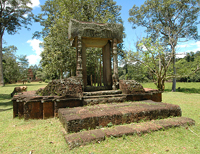 |
Thma Bay Kaek |
AAP/PC |
Late 11th / early
12th century AD |
Suryavarman II |
Angkor Wat |
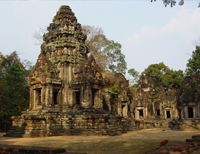 |
Thommanon
Picturesque little temple in very
good condition. Whether wet or dry, the stone picks up colors
beautifully. Photogenic. |
AAP/PC |
Late 11th - Early 12th
century AD |
Suryavarman II |
Angkor Wat |
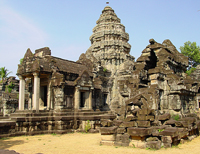 |
Wat Athvea
Distinctively Angkor Wat style
temple in a countryside setting no far from town. |
8km south of Siem
Reap Town. |
Late 11th century AD |
Suryavarman II |
Angkor Wat |
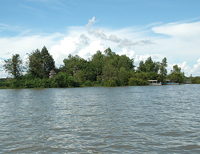 |
West Mebon
Remnants of an island temple in the
middle of the west baray. |
AAP - On an island in
the center of the West Baray |
Late 11th century AD |
Udayadityavarman VII |
Baphuon |
-----------------------------------------------------------------------------
--------------------------------------------------------------------------------------------------
-----------------------------------------------------------------------------
|
Temples of
Kampong Thom Province
(Back to top)
The following temple ruins are located in
Kampong Thom Province in central western Cambodia. Kampong Thom
Province borders Siem Reap province to the east and harbors one
on the most important ancient Khmer temple complexes outside of
the Angkor Archaeological Park (i.e.
Sambor Prei Kuk)
as well as dozens of minor ruins. The road from Phnom Penh to
Siem Reap (National Route #6) passes through Kampong Thom
Province and within easy visiting distance of Sambor Prei Kuk
and several of the minor ruins that lie just off the road.
If you have the opportunity to take some sort of private
transportation between Siem Reap and Phnom Penh such as
motorcycle or private taxi it is possible to stop briefly and
visit several ruins along the way. |
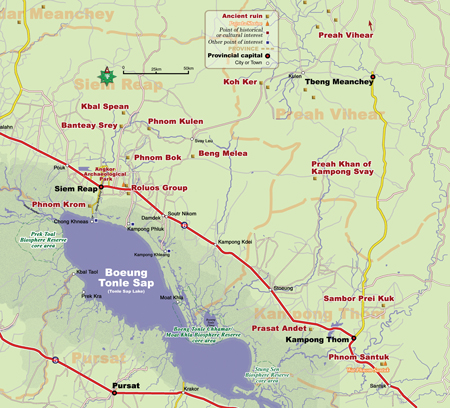 |
|
|
Ruin |
Location |
Date of Construction |
King/Patron |
Style |
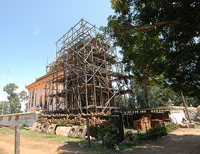 |
Phum Prasat |
Kampong Thom province |
7th century AD |
Suryavarman I |
-- |
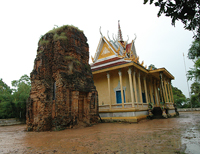 |
Prasat Andet |
Kampong Thom province |
6th-7th
century AD |
--- |
--- |
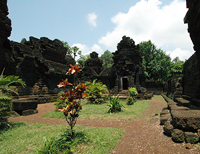 |
Prasat Kuhak Nokor
Peaceful setting. |
Kampong Thom province |
11th
century AD |
-- |
-- |
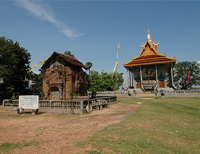 |
Prasat Poo-Wee-Ung |
Kampong Thom province |
7th
century AD |
-- |
-- |
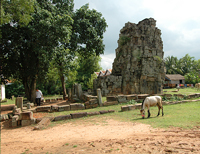 |
Prasat Preah Te-it
a.k.a. 'The Leaning tower of Kampong Thom' |
Kampong Thom province |
Pre-Angkorian |
|
-- |
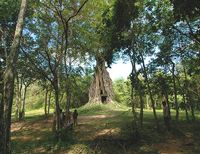 |
Sambor Prei Kuk
Extensive, archaeologically
important temple complex. |
Kampong Thom province |
7th century AD |
Isanavarman I |
Sambor Prei Kuk |
-----------------------------------------------------------------------------
--------------------------------------------------------------------------------------------------
-----------------------------------------------------------------------------
|
Temples of
Takeo Province
(Back to top)
The following temple ruins are located in
Takeo Province south of Phnom Penh,
within a day-trip's distance. The pre-Angkorian and Angkorian-era temple ruins in
Takeo Province, though not as impressive as the
temples near Siem Reap, rank amongst the most historically and
archaeologically important Khmer ruins in Cambodia. Most of the listed
temple ruins can also be reached by bus. Regularly scheduled buses
depart the bus station near Phnom Penh’s Central Market and
follow the National Routes into the provinces. Most of the
listed sites lie on or near a National Route. For sites located
away from the National Route, onward transportation awaits bus
passengers at the bus stops. See the
Temple Ruins Near
Phnom Penh Map for Takeo province temples. |
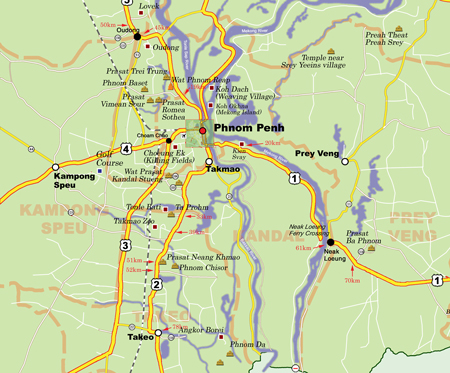 |
|
|
Ruin |
Location |
Date of Construction |
King/Patron |
Style |
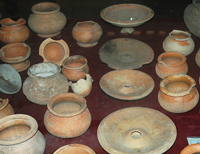 |
Angkor Borei |
Takeo Province |
Neolithic - 15th
century AD |
--- |
--- |
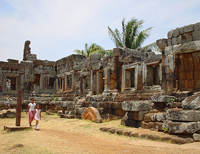 |
Phnom Chisor |
Takeo Province, just
off Route #2 |
10th-11th century AD |
Suryavarman I |
-- |
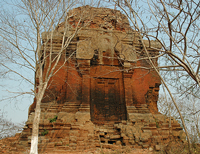 |
Phnom Da |
Takeo Province |
Mid-11th
century AD |
Rudravarman |
-- |
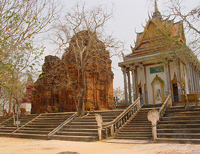 |
Prasat Neang Khmau |
Takeo Province, just
off Route #2 |
10th
century AD |
Jayavarman IV |
-- |
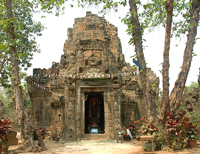 |
Ta Prohm at
Tonle Bati |
Takeo Province, at
Tonle Bati resort area |
12th century AD |
Jayavarman VII |
-- |
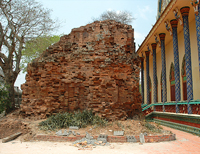 |
Yeah Peau |
Takeo Province, at
Tonle Bati resort area |
12th century AD |
Jayavarman VII |
-- |
-----------------------------------------------------------------------------
--------------------------------------------------------------------------------------------------
-----------------------------------------------------------------------------
|
Temples of
Preah Vihear Province
The following temple ruins are located in
Preah Vihear Province,
the province bordering Siem Reap Province to the northwest. The Angkorian-era temple ruins
of Preah Vihear rank among some of the more important and
impressive outside of the Angkor Park area in Siem Reap. The
temple complex at Koh Ker, for example, encompasses more
than a dozen temples and represents the remnants of a rival
capital city from the Age of Angkor. And the Preah Vihear Temple
on the Thai border - the center of recent political controversy
- displays a unique artistic style and stands with a commanding
view of the Cambodian plain. Some of the temple ruins of Preah
Vihear are comparatively easy to reach, such as Koh Ker which is
within half-day trip. Others such as the remote Preah Khan at
Kampong Svay requires significant more time and effort to reach. |
 |
|
|
Ruin |
Location |
Date of Construction |
King/Patron |
Style |
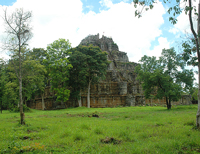 |
Koh Ker
Extensive, archaeologically
important temple complex. |
Preah Vihear province, within 1h.30m
driving distance of Siem Reap. Province |
10th
century AD |
Jayavarman IV |
--- |
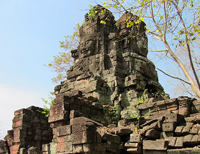 |
Preah Khan at Kampong Svay (Bakan) |
Preah Vihear province |
11th - late 12th century |
Suryavarman I & II and Jayavarman
VII |
-- |
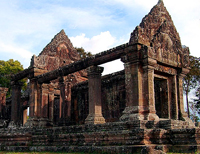 |
Preah Vihear
Unique ruins with a spectacular view
of the Cambodian plain. |
Preah Vihear province near the
border with Thailand |
Late 9th - mid- 12th centuries AD |
Yasovarman I and Suryavarman I & II |
-- |
-----------------------------------------------------------------------------
--------------------------------------------------------------------------------------------------
-----------------------------------------------------------------------------
|
|
Ruin |
Location |
Date of Construction |
King/Patron |
Style |
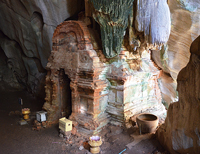 |
Phnom Chhnork
Pre-Angkorian ruin in a cave. |
Kampot province, east of
Kampot town,
between Kampot and
Kep. |
7th century AD |
--- |
--- |
-----------------------------------------------------------------------------
--------------------------------------------------------------------------------------------------
-----------------------------------------------------------------------------
Glossary
(Back to top)
Anastylosis Archaeological technique used in
reconstructing the temples ruins by dismantling and then
rebuilding. This technique was used on
Banteay Samre,
Prasat
Kravan,
Thommanon
and many other temples.
Angkor Angkor refers to the capital city of the Khmer
Empire that existed in the area of Cambodia between the 9th and
12th centuries CE, as well as to the empire itself.
Apsara Mythological a celestial nymph. Devatas (standing
female divinities), though technically different, are also
referred to as apsaras in this guide. Carved in abundance on
many of the temples.
Banteay (Khmer) 'fortress' or 'citadel'. Though not a
technical designation, it often indicates a monastic complex or
flat temple style.
Baray (Khmer) A ‘baray’ is a water reservoir - an
area of land where dikes have been raised to catch and hold
water. Beginning in the 9th century, the construction of massive
barays and other such grand projects became one of the marks of
Angkorian kingship. There are four major barays in the Park
area. When the barays were constructed, an island temple was set
at the center of each. The first major baray to be constructed
was Indratataka by King Yasovarman I, measuring 3.8km x 880m and
completed in 889AD when the capital was still at Hariharalaya
near Roluos. The
Roluos
Group temple
Lolei
sat on an island in the middle of Indratataka. Construction of
the second major baray, the East Baray
(Yashodharatataka,) began almost immediately after the first. At
7.8km x 880m it was almost five times larger than the
Indratataka. Almost 50 years later, the temple
East Mebon was
constructed on an island in the center. The third and largest
baray (8km x 2.2km) is the West Baray built in the early
11th century. Unlike the other barays, the West Baray is
still partially filled, creating good sized lake. The temple
ruins of West Mebon sit on an artificial island at the
center of the baray (requiring a short boat ride to visit.) The
last baray (Jayatataka) was constructed by Jayavarman VII in the
late 12th century. It is considered to be the baray of Preah
Khan though it is Neak Pean that actually sits at the center.
The function of barays is a matter of academic debate. A recent
study has argued that the barays did not serve an agricultural
purpose but were built and maintained solely for
political/religious reasons. Conventional wisdom has it that the
barays were part of a giant water works used to irrigate the
rice paddies and provide water for year round cultivation,
though they certainly served a political and religious function
as well.
Boeung (Khmer) 'lake'. Also spelled ‘beng’.
Champa Neighboring Indianised state, contemporary with
Angkor. Located in the area of south central Vietnam.
Corbel arch False arch made from placing tiered,
progressively projecting corbels on opposite walls. Used
throughout Angkorian era construction.
Gopura The entrance-way or gate in the wall that
surrounds a temple.
Khmer The dominant ethnic group and the language of
ancient and modern Cambodia.
Linga A phallic symbol, representative of the god Shiva.
Lintel The sandstone block above doorways and windows,
often intricately carved.
Monastic complex General term referring to a temple that
has a relatively flat, sometimes sprawling architectural layout.
It may employ towers, but set at ground level, e.g.:
Ta Prohm,
Preah Khan,
Banteay Kdei.
Naga Mythological, multi-headed snake/serpent. Naga
motifs are often used in balustrades.
Phnom (Khmer) 'hill' or 'mountain'.
Prasat (Khmer) 'tower'.
Preah (Khmer) 'sacred'.
Reamker Khmer telling of the Ramayana, a classic and much
loved epic tale from Hindu mythology - the adventures of Rama in
his quest to save his kidnapped wife, Sita, from Ravana. Images
from the Ramayana are carved on many temples including Angkor
Wat, and traditional dance performances in Siem Reap often
incorporate stories from the Ramayana.
Shiva One of the three primary gods of the Hindu trinity.
The ‘destroyer’. Central to the Angkor royal linga cult. Often
represented in the form of a linga.
Stele Inscribed stone tablet.
Stung (Khmer) 'river'
Temple-mountain A specific architectural design based on
the mythological mountain, Mt. Meru. Eg:
Pre Rup,
Ta Keo,
Bakong.
Thom (Khmer) 'big,' e.g.
Angkor Thom
-varman (Khmer) ‘protected by’. The suffix attached to the names
of Khmer kings, e.g.: Suryavarman, Jayavarman.
Vihear (Khmer) Main temple building of a Buddhist
pagoda or temple group. Houses the Buddha image.
Vishnu One of the three primary gods of the Hindu
trinity. The ‘protector’.
|









































































